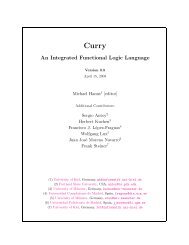Conformal Geometric Algebra in Stochastic Optimization Problems ...
Conformal Geometric Algebra in Stochastic Optimization Problems ...
Conformal Geometric Algebra in Stochastic Optimization Problems ...
You also want an ePaper? Increase the reach of your titles
YUMPU automatically turns print PDFs into web optimized ePapers that Google loves.
222 CHAPTER 8. APPLICATIONS IN OMNIDIRECTIONAL VISION<br />
6.1 can be exploited such that every pair of correspondence po<strong>in</strong>ts (x,y) yields the<br />
G-condition<br />
g t (p, x,y) = x k O t kc (p r G a rl y l G c ab R b s p s ), (8.8)<br />
where Φ(G) = g, Φ(X) = x, Φ(Y ) = y and Φ(M) = p. As usual, the product<br />
tensors O, G and R denote the outer product, the geometric product and the reverse,<br />
respectively. Likewise, for the motor M the familiar parameterization p ∈ � 8 is<br />
chosen.<br />
Note that only a particular <strong>in</strong>dex t = t ⋄ , that is the one <strong>in</strong>dex<strong>in</strong>g to the e ∗ ocomponent<br />
of the result, has to be taken <strong>in</strong>to account. After sett<strong>in</strong>g F = eo it<br />
can be shown that x and y <strong>in</strong> fact denote the Euclidean 3D-coord<strong>in</strong>ates on the<br />
projection spheres, i.e. x, y ∈ � 3 . Consider<strong>in</strong>g the motor p as constant, the bil<strong>in</strong>ear<br />
form<br />
g(x,y) = x k Ekl y l ∈ �<br />
with<br />
Ekl = O t⋄<br />
kc p r G a rl G c ab R b s p s<br />
is obta<strong>in</strong>ed. The condition is l<strong>in</strong>ear <strong>in</strong> X and l<strong>in</strong>ear <strong>in</strong> Y as expected by the<br />
bil<strong>in</strong>earity of the geometric product. Its succ<strong>in</strong>ct matrix notation is<br />
x T Ey = 0 , (8.9)<br />
where E ∈ � 3×3 denotes the essential matrix of the epipolar geometry. No proof<br />
is given, but it is mentioned that equation (8.9), which ultimately reflects a triple<br />
product, is zero if and only if there is coplanarity between the four po<strong>in</strong>ts F ′ , Y ′ ,X<br />
and F. Next, if sett<strong>in</strong>g Y ′ = E ′ or X = E one gets E y = 0 and x T E = 0,<br />
respectively. Otherwise, say Ey = n ∈ � 3 , an X can be chosen such that the<br />
correspond<strong>in</strong>g x is not orthogonal to n, whence x T Ey �= 0. This would imply<br />
that the po<strong>in</strong>ts F ′ , E ′ , F and the chosen X are not coplanar, which must be a<br />
contradiction s<strong>in</strong>ce F ′ , E ′ and F are already coll<strong>in</strong>ear. Hence the 3D-epipoles reflect<br />
the left and right null space of E, and it can be <strong>in</strong>ferred that the rank of E can be<br />
at most two.<br />
Because E does solely depend on the motor M, which embodies the extr<strong>in</strong>sic parameters,<br />
it can not be a fundamental matrix, which must <strong>in</strong>clude the <strong>in</strong>tr<strong>in</strong>sic<br />
parameters as well. Fortunately, the previous derivations can easily be extended<br />
to obta<strong>in</strong> the fundamental matrix F. Recall the image po<strong>in</strong>ts x and y. They are<br />
related to X and Y <strong>in</strong> terms of a stereographic projection. As already stated <strong>in</strong><br />
section 8.1, a stereographic projection is equal to an <strong>in</strong>version <strong>in</strong> a certa<strong>in</strong> sphere,<br />
but <strong>in</strong>version is the most fundamental operation <strong>in</strong> CGA. In accordance with figure<br />
8.2 it can be used X = SIxSI. Note that the <strong>in</strong>version sphere SI depends on the<br />
focal length of the parabolic mirror. In this way equation (8.7) becomes<br />
G = F ∧ (SIxSI) ∧ F ′ ∧ (SIy ′ SI) e∗o = 0.<br />
In addition, the image center (specifically, the coord<strong>in</strong>ates of the pixel where the optical<br />
axis hits the image plane) can be <strong>in</strong>cluded by <strong>in</strong>troduc<strong>in</strong>g a suitable translator<br />
TC. Hence SI would have to be replaced by the compound operator Z := SITC<br />
G = F ∧ (Zx � Z) ∧ F ′ ∧ (Zy ′ � Z)<br />
e ∗ o<br />
= 0. (8.10)
















